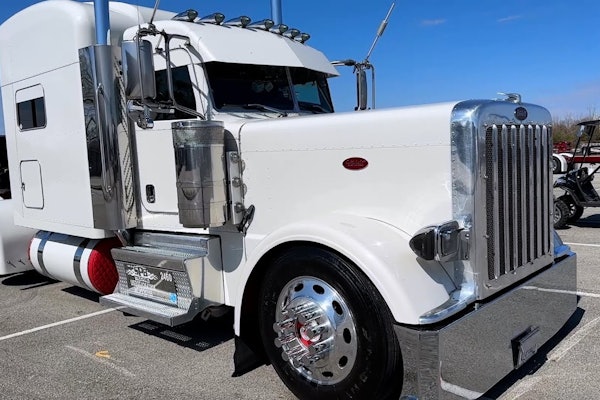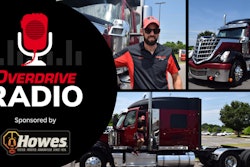Angler John Jolly was reasonably certain these huge bears were more interested in salmon than him.
How many of you catch yourself saying you’ve been driving “in the middle of nowhere?”
John Jolly sends his big rig drivers into one of the most “nowhere” places in America, the vast openness of Alaska. Jolly, a general manager with World Wide Movers in Anchorage, also likes to get out into that wilderness in search of game and fish. Especially if the object is to catch (and release) big (really big) rainbow trout.
Being in a very remote part of the world isn’t the only thing Jolly has to take into account when he fishes the Kulik River in the fall. A large gathering of very big and very hungry brown bears like to fish the same, shallow stretch of water at the same time he does.
“I was out there fishing one day and counted 29 of them in less than a mile of water,” says Jolly. “And they were close to me. Very close.”
A native of Oregon who went north to Alaska in his early twenties, Jolly, 43, got into trucking by accident. He was working as a lineman, but “when winter freezes the ground, everything slows way down up here,” and he was often left with no work. His brother-in-law found him a job in trucking as a driver, and he’s never left the industry.

World Wide Movers’ Alaskan trucks drive the entire state, including the long, brutal run from Fairbanks to Prudhoe Bay, on the treacherous, graveled “Haul Road” (officially the Dalton Highway, which runs parallel to the Trans-Alaska oil pipeline) with only one stop at the world’s northernmost truckstop at Coldfoot above the Arctic Circle.
“These days I mostly send office furniture and equipment up to Prudhoe, although we do carry some computers and other sensitive commercial loads that need an air ride on the haul road,” says Jolly.
Fishing is important enough to Jolly that a six-hour drive to the right river or bay to follow salmon runs or to look for Halibut, rainbow trout, Dolly Varden or other fighting species is just a weekend outing. But his encounter with the band of bears on the Kulik was an hour’s flight and a 45-minute helicopter ride from Anchorage.
“Actually I was up there working in the fall, and there was plenty of time to walk down to the river and fish.”
The Kulik is a short river, less than two miles long, a connector between two lakes on the Alaskan Peninsula southwest of Anchorage. “It’s an amazing place to fish. It’s as clear as crystal and only wading deep. The salmon run in from Bristol Bay in the summer and fall, and they spawn in the river in the fall. Then the river is thick with them; they’re red with eggs and after they lay them, they will die. The rainbow trout come in to feast on the eggs.”
Jolly and four other World Wide Movers men – including three drivers – fished for the rainbows. “It’s seems funny, but all those salmon were really a nuisance. We were after the rainbows. It was all catch and release, and there were some really big fish in the water. We got a couple right at 30 inches, the others between 20 and 30 inches. I’d say the biggest of them were around 10 pounds. We were strictly fly fishing by choice. Most everybody that fishes out there chooses fly fishing. It’s so much more fun; those rainbows are the hardest fighters.”
Jolly and his colleagues were at the Kulik helping a lodge remodel. Building material was airlifted from Anchorage into Kulik by giant Hercules aircraft and then taken by helicopter to the lodge site. A total of 18 Hercules loads came into the gravel airstrip at Kulik, and there were 340 round trips with the helicopter fitted with special skids carrying loads of no more than 3,000 pounds.
A cold, snowy fall day on the Kulik and the water between John Jolly and that bear is only wading depth.
“Fortunately there were some days the helicopter couldn’t fly. Those were fishing days. I’d fished there before; I knew what a spectacular river it was. And I knew there’d be bears. They’re there because there is so much salmon, a staple in their diet. They stay there until Thanksgiving, until the salmon are gone.
“The U.S. Geological Survey has identified 75 bears along that short river.”
The Alaskan Brown Bear has an acute sense of smell. It doesn’t see very well, and it’s hearing is not the sharpest in the animal kingdom, but if you are standing out in the open water of a small, shallow river, it will know you are there. And this species is known to occasionally kill and eat larger animals.
“I used to worry about them at first, but you get used to them. There’s so much food I guess they don’t even need to think of us as food. As long as you don’t get between a sow and a cub, or between two males bristling over territory, they leave you alone. Of course that doesn’t mean you don’t want to know where they are when you are out in the middle of the river. They’ll drift along with the current and sometimes if you don’t stay alert they’ll be right up beside you.
“I don’t know that I’ve ever really gotten over being nervous having them there. They’re kind of scary until you get used to them, and even then you spend a lot of time looking over your shoulder. But now I’m just aware of them all the time. I used to take a gun, but I don’t any more. And they are very intelligent and curious, so they might find you interesting if they get close enough.
“The biggest of the bears on the Kulik are probably eight feet tall and maybe 1,300 pounds. I have a great respect for them. For me they are the king of the beasts. To be that close to them is amazing.”
Jolly got to fish the river again when he and his men went back after the winter freeze to finish the work begun the previous fall.
“It’s a different sort of life up here, and it’s a different sort of driving. We do solo and team, and we’re always looking for drivers who can handle Alaska. It’s not the same as down there,” Jolly says. “Take the traffic volume for example. Here you can go for hours and not see anyone, and there’s not a gas station on most corners. There’s a lot of planning that goes into loads going a long way on our roads. Leave Fairbanks heading north, and you have to take your own spares and impact wrenches and jacks. You get a flat, they don’t send the Goodyear man out.”
One thing you may like if you go north to drive. “We have an hours-of-service exception up here,” says Jolly. “We can drive 15 hours a day and be on duty for twenty hours. Down there you can drive 60 hours in seven days; here it’s 70. That’s necessary, because only in the best conditions can you do Fairbanks to Prudhoe in twelve hours.”
Married 23 years, Jolly now takes son Matthew, 18, a fine fisherman in his own right, along on trips to distant rivers and bays, and his wife Susan and daughter Amanda, 16, also love to fish.
“Matthew is like me; he loves this Alaskan country. He’s a guide in some pretty remote country, and he’s a natural when it comes to fishing. He caught an 86-pound King Salmon when he was ten. He’s got the touch.”
Dan Durnwald’s favorite picture from the lake is this one: his daughter and niece toss a bucket over Dad as Ann’s mom and stepdad enjoy the fun at a big family outing.
Rods & Barrels
Family Time at the Lake
When driver Dan Durnwald heads into the great outdoors (and that’s most weekends), he’s never alone. “The kids would never let me head out in the boat or camp out in the camper if they weren’t along,” says the veteran Heartland Express OTR driver who handles a 2003 Freightliner Columbia. Durnwald, with Kortney, 7, David, 4, and wife Ann, drives from hometown Bloomville, Ohio, to camp near the islands and waters of Lake Erie near Sandusky, Ohio. (see our Destinations story).
“I started boating before I was a year old,” Dan says. “I’d just strap on a life jacket and away we’d go. That’s a love of the outdoors you pass on to your kids, and they both started before they were one, too.” Today that means weekends riding a 21-foot Bayliner and living in a 39-foot camper. “He’s a family man every hour of the day,” says wife Ann, “whether he’s on the road or home or up at the lake.
To the hunters featured in Rods & Barrels, Henry Repeating Arms will donate a Henry Golden Boy .22 rifle.
Got a picture of you with your trophy game or fish? Send a copy to John Latta at Truckers News, 3200 Rice Mine Road, Tuscaloosa, AL 35406, and it might be featured in a future Great Outdoors section.
Off-Duty Destinations
Lake Erie Islands State Park
This state park is actually four state parks: Kelleys Island, Catawba Island, South Bass Island and Oak Point, and a number of smaller islands.
The shoreline alone is worth a drive. All sorts of watersports are available, and the fishing is exceptional. Erie has more fish, and more varieties of fish, than any other Great Lake, with yellow perch, smallmouth bass, white bass, channel catfish and walleye the most common catches.
And good news about Rattlesnake Island – there are snakes, but the local poisonous ones the island was named for are extinct.
Migrating songbirds rest here, and so many species have been identified that the park is one of the finest birdwatching spots in America. Pictographic writings from ancient Indian tribes, some more than 500 years old, are etched here on Inscription Rock. With the longest frost-free period anywhere in Ohio, early settlers cultivated grapes, and the islands became known as the “Wine Islands.” Several island wineries still exist.
Nearby Marblehead Lighthouse State Park is home to the oldest lighthouse in continuous operation on the Great Lakes.
As always, we recommend you call before you go. Park headquarters in Port Clinton, Ohio, is (419) 797-4530. To get to Port Clinton, take State Highway 53 north off the Ohio Turnpike at exit 91 near Kingsway or choose an exit from the pike that goes to Sandusky and take State Highway 2 south of Sandusky over the Bay View Bridge to the Marblehead Peninsular.
And keep this park in mind even in winter. The scenery is still spectacular, and you can ice fish or ice skate and cross country ski, too.








